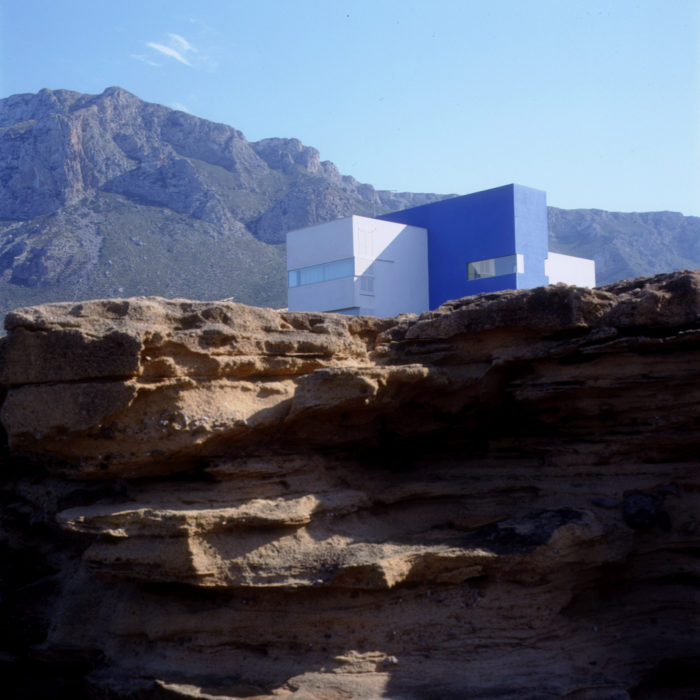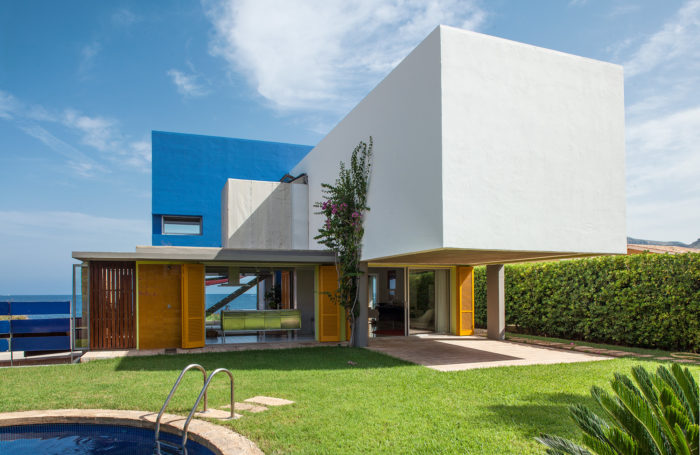This website uses cookies so that we can provide you with the best user experience possible. Cookie information is stored in your browser and performs functions such as recognising you when you return to our website and helping our team to understand which sections of the website you find most interesting and useful.




by Cristina Ros, 21 July 2019
To understand the reason for this house, you have to see it from the sea. From the water of the Bay of Alcúdia, in a spot close to the Colònia de Sant Pere, a series of geometric volumes, an interplay of white and blue, emerge between the rocks eroded by the force of the waves and a nearby mountainous backdrop, between Ferrutx Hill and the cape of the same name. Very close to the sea, and at the foot of the steepest slope of the Talaia Freda (the highest mountain in the eastern range), the summer home designed two decades ago by Catalan architect Josep Lluís Mateo allows its occupants to merge with the landscape and also find protection from it. The Mediterranean is not always a sea of stillness. And, at the spot where this house stands, the tramuntana, the north wind, blows hard; on some days, very hard.
Natural conditioning factors
Nature rules. Aware of the strong conditioning factors of a location that is as special as it is wild, Josep Lluís Mateo designed the house as an almost hermetic lookout over the sea the north of Majorca. It is a lookout because the façade that overlooks the sea comprises long, generously-dimensioned non-opening windows, which, from inside the house, from the living room on the ground floor, and also from the master bedroom and a small study on the top floor, offer an unsurpassed panoramic view of the Bay of Alcúdia, with Formentor in the distance. Contemplation and protection are guaranteed. From morning to night, from the habitual serenity of waking, to a splendid sunset, in this house you share all the colours and shapes that the sea offers in a single day.
Likewise conditioned by the lashing of the sea and the wind, and by the desire to view the seascape with no visual obstacles, the garden that lies between the house and the rocks adopt the austerity of low-growing native shrubs, a grey-green underscoring of the seascape.
Sunlight and air enter at the rear, through the living room and the kitchen, which are completely open to the mountains, the morning sun and the back garden, where there is a small swimming pool. In this line of sight, the architecture of the house challenges the hill range that is its natural curtain, presenting to it a white, cube-shaped volume on the top floor that rises with determination towards the mountains and creates a large porch for sheltered use. It is an intimate volume that houses a bedroom for guests, who have the option of an independent entrance via a playful folding stairway.
The lattice wall of a patio
In this family house in the north of Majorca, everything is sized just right for carefree holidays with the aim, no more and no less, of experiencing the landscape and the sea. The living room turns towards the immensity of the picture window, presenting its back to the dining room and an area to relax and read in. Not much furniture; the basics. Beside it, the utilitarian kitchen multiplies its space thanks to the sliding doors that open onto the garden and a patio, one of the most welcoming parts of the house.
This space, covered by just a light cane structure and closed on the side nearest to the neighbours by a sandstone wall built as a lattice with specially cut pieces and spaces left between them, offers views of the sea without its inclemency. It is also the space that enables ventilation of the house, and the volume that integrates the rugged sandy presence of the nearby worn rocks.
The lattice wall, built of the sandstone traditionally used to construct houses in Majorca, is seen from the outside as a natural counterpoint to the radiant white and intense blue of the two main volumes of a house that is sculptural. In a definite perpendicular arrangement, almost as a guide for the cardinal points, the blue volume runs east to west, while the white volume runs from north to south, between the sea and the mountains.
Family house
Josep Lluís Mateo, architect
Colònia de Sant Pere, Majorca
Photo:
Gabriel Ramón and Duccio Malagamba
A microclimate for a microcosm
“The house is a microcosm, with unlimited spatial possibilities: above and below, in front and behind, top and bottom, open and closed”, wrote the architect and theorist Ignasi de Solà-Morales (Barcelona, 1942-Amsterdam, 2001) in 2001 after a visit to the holiday home that the architect Josep Lluís Mateo had just built. The glazed patio, separated from the street by a lattice wall of sandstone blocks, creates a microclimate for the microcosm of the house. It provides protection even as it welcomes in the immensity of nature and all its energy.

Text originally featured in Diari Ara


